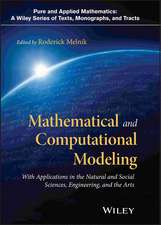Mathematical Modeling for Complex Fluids and Flows
Autor Michel Deville, Thomas B. Gatskien Limba Engleză Paperback – 22 feb 2014
The book develops a descriptive mathematical model articulated through continuum mechanics concepts for these non-Newtonian, viscoelastic fluids and turbulent flows. Each complex fluid and flow is examined in this continuum context as well as in combination with the turbulent flow of viscoelastic fluids. Some details are also explored via kinetic theory, especially viscoelastic fluids and their treatment with the Boltzmann equation. Both solution and modeling strategies for turbulent flows are laid out using continuum concepts, including a description of constructing polynomial representations and accounting for non-inertial and curvature effects.
Ranging from fundamental concepts to practical methodology, and including discussion of emerging technologies, this book is ideal for those requiring a single-source assessment of current practice in this intricate yet vital field.
| Toate formatele și edițiile | Preț | Express |
|---|---|---|
| Paperback (1) | 387.58 lei 6-8 săpt. | |
| Springer Berlin, Heidelberg – 22 feb 2014 | 387.58 lei 6-8 săpt. | |
| Hardback (1) | 394.87 lei 6-8 săpt. | |
| Springer Berlin, Heidelberg – 13 ian 2012 | 394.87 lei 6-8 săpt. |
Preț: 387.58 lei
Nou
Puncte Express: 581
Preț estimativ în valută:
74.16€ • 77.59$ • 61.61£
74.16€ • 77.59$ • 61.61£
Carte tipărită la comandă
Livrare economică 03-17 aprilie
Preluare comenzi: 021 569.72.76
Specificații
ISBN-13: 9783642435607
ISBN-10: 3642435602
Pagini: 284
Ilustrații: XX, 264 p.
Dimensiuni: 155 x 235 x 15 mm
Greutate: 0.4 kg
Ediția:2012
Editura: Springer Berlin, Heidelberg
Colecția Springer
Locul publicării:Berlin, Heidelberg, Germany
ISBN-10: 3642435602
Pagini: 284
Ilustrații: XX, 264 p.
Dimensiuni: 155 x 235 x 15 mm
Greutate: 0.4 kg
Ediția:2012
Editura: Springer Berlin, Heidelberg
Colecția Springer
Locul publicării:Berlin, Heidelberg, Germany
Public țintă
ResearchCuprins
1. Introduction.- 2. Tensor Analysis, Invariants, and Representations.- 3. Kinematics and Dynamics.- 4. Constitutive Equations: General Principles.- 5. Non-Newtonian and Viscoelastic Fluids.- 6. Turbulent Flows.- 7. The Boltzmann Equation.- 8. Properties of the Hermite Polynomials.- Table of symbols.-
References.
References.
Textul de pe ultima copertă
Mathematical Modeling for Complex Fluids and Flows provides researchers and engineering practitioners encountering fluid flows with state-of-the-art knowledge in continuum concepts and associated fluid dynamics. In doing so it supplies the means to design mathematical models of these flows that adequately express the engineering physics involved. It exploits the implicit link between the turbulent flow of classical Newtonian fluids and the laminar and turbulent flow of non-Newtonian fluids such as those required in food processing and polymeric flows.
The book develops a descriptive mathematical model articulated through continuum mechanics concepts for these non-Newtonian, viscoelastic fluids and turbulent flows. Each complex fluid and flow is examined in this continuum context as well as in combination with the turbulent flow of viscoelastic fluids. Some details are also explored via kinetic theory, especially viscoelastic fluids and their treatment with the Boltzmann equation. Both solution and modeling strategies for turbulent flows are laid out using continuum concepts, including a description of constructing polynomial representations and accounting for non-inertial and curvature effects.
Ranging from fundamental concepts to practical methodology, and including discussion of emerging technologies, this book is ideal for those requiring a single-source assessment of current practice in this intricate yet vital field.
The book develops a descriptive mathematical model articulated through continuum mechanics concepts for these non-Newtonian, viscoelastic fluids and turbulent flows. Each complex fluid and flow is examined in this continuum context as well as in combination with the turbulent flow of viscoelastic fluids. Some details are also explored via kinetic theory, especially viscoelastic fluids and their treatment with the Boltzmann equation. Both solution and modeling strategies for turbulent flows are laid out using continuum concepts, including a description of constructing polynomial representations and accounting for non-inertial and curvature effects.
Ranging from fundamental concepts to practical methodology, and including discussion of emerging technologies, this book is ideal for those requiring a single-source assessment of current practice in this intricate yet vital field.
Caracteristici
Self-contained theoretical approach Based on continuum mechanics and kinetic theory Focus on non-Newtonial fluids New, greatly expanded edition of popular standard monograph ? Includes supplementary material: sn.pub/extras
















